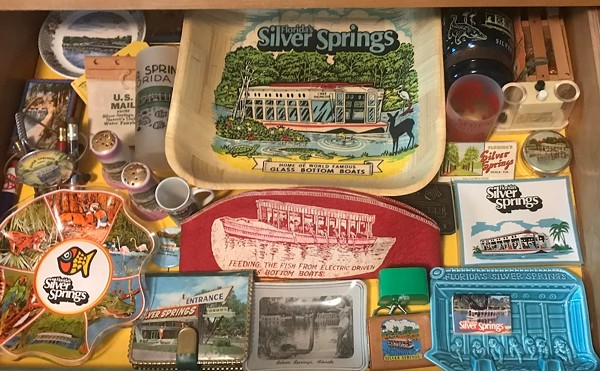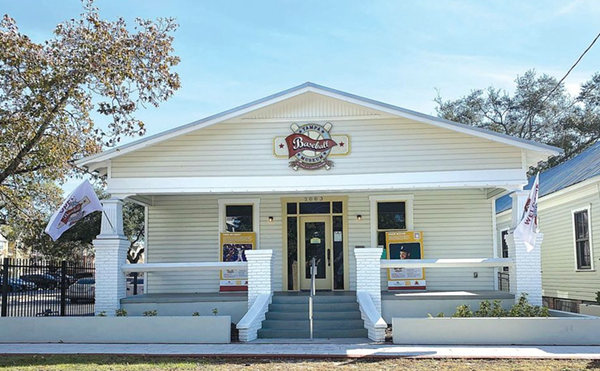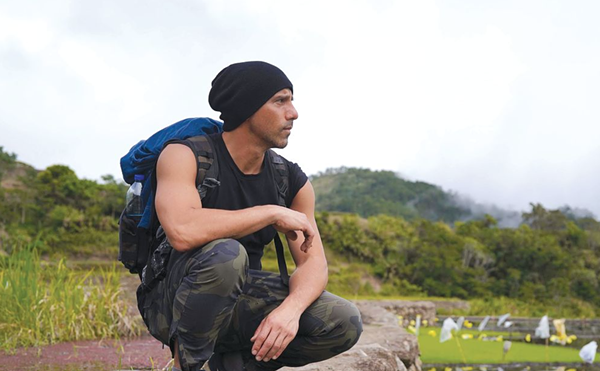No fewer than four shows currently vie for attention at St. Pete's Museum of Fine Arts — not to mention a whole wing of items from the permanent collection. The quantity and diversity at times creates the feeling of a haphazard art buffet, but the MFA carries it off with panache. The small exhibits inform one another in a dynamic, conversational way.
Works in two and three dimensions by modernist Alexander Archipenko headline the extravaganza. An intimate room of Picasso prints provides an illuminating contrast to Archipenko. (According to the museum's website, the Picasso prints come down after June 11.) A number of sculptures in the permanent collection, from pre-Colombian to African to classical examples, offer additional, thought-provoking context.
Post-1950 works from the MFA collection stand on their own but also continue two themes present in Archipenko: abstraction and works on paper. Contemporary French works on loan from Bleu Acier and a Vicky Colombet painting recently donated to the museum round things out with a splash.
Archipenko emigrated from Ukraine to Paris while in his early 20s. Before and after WWI, he exhibited frequently with a crowd of artists that included orthodox cubists as well as those loosely influenced by that movement: Juan Gris, Francis Picabia, Fernand Léger, as well as Marcel Duchamp and his brothers, Jacques Villon and Raymond Duchamp-Villon. All were influenced by Picasso and Georges Braque but hoped to move beyond them with their own unique styles.
In 1923, Archipenko and his wife left Europe for America, where the artist lived until his death in 1964. During those years, he continued to sculpt and make prints, living the itinerant life of a university and private instructor, teaching and sometimes opening his own intimate art schools in New York, Los Angeles, Seattle, and Chicago, to name a few of the cities he called home.
Works at the MFA trace a timeline from Archipenko's first, realistic sculptures, to cubist lithographs and etchings, to his discovery of negative space. With the use of voids to represent mind, breast, or tension between figures, the works take on a symbolism that catapults them into a deeper and less derivative context.
Like many artists of his generation, Archipenko evinces a modernist fascination with technology and the mythology of progress. Traditional subjects like the female nude take on a streamlined, geometrical appearance suggestive of machinery and transportation vehicles. A woman embracing the helmet-shaped head of man recalls the angularity of Art Deco, an iconic architectural style in midtown Manhattan where Archipenko taught. A bronze of King Solomon evokes a rugged, animal-like individuality.
The real show-stopper in the exhibit is a portfolio of lithographs titled "Living Forms" — one of the last works Archipenko produced. Bold, biomorphic abstractions reveal the influence of Picasso and Miro, with a heft and physicality all Archipenko's own. The combination of a complete departure from realism with an allegiance to organic form creates fertile ground for the imagination; it's hard not to be entranced by the fanciful and symbolic prints.
Post-1950 works drawn from the permanent collection forge a path from Archipenko to the contemporary French works on view in the furthest gallery. Many venture even further into abstraction, sometimes bringing color into the mix or playing along the division between organic and artificial.
Ibram Lassaw's black and white grid suggests city blocks, skyscraper windows or rectangular cell walls. Martin Canin's painting of color gradations from peach to fuschia basks in the pink neon of Paul Seide's nearby fluorescent sculpture. A kaleidoscopic combination of color and shape by Victor Vasarely takes that form of abstraction — precise and coldly beautiful — to its logical conclusion. Willem de Kooning sits at the opposite end of the axis, rendering the female form in a few sloppy flesh-toned brushstrokes.
A beautiful gift to the museum in the form of a large abstract painting by Vicky Colombet anchors the final gallery filled with contemporary works by French artists. Colombet, a Paris-born artist who lives in New York, uses gravity and folds of canvas to coax her pigments into subtle maps of fluid dynamics. The delicate swirls and branching rivulets evoke blood vessels, riverbeds, tree roots and traffic patterns. In a color palette that suggests film negatives or x-rays, the images take on a vertiginous uncertainty of scale.
A connection or evolution exists — however much it might seem like a leap of faith — between the technological zeitgeist manifest in Archipenko, Columbet, and the artists and art works that span between them in the exhibits. Where Archipenko depicts concrete, sensual shapes available to the naked eye, Colombet portrays the hidden forces of complexity theory: one image of organic reality in contrast to another.
The last images in the gallery, two lithographs by Bernard Venet hanging in a tiny alcove next to an exit, read as a clever inside joke. In a narrative of abstraction from cubism to the physics of drip and spill, it's fitting that these final prints should depict mathematical formulas. One gives the equation of a line then graphs it for visual effect, demonstrating the basic building block of two-dimensional visual art. The other image shows the chemical recipe for a molecule of methane and a drawing of the three-dimensional cluster of atoms — the molecule as microscopic sculpture/structure.
Ironically, in the years since these prints were made, making an image from individual molecules has gone from concept to reality. Vik Muniz accepted the help of a few technicians to create a work on an order of magnitude larger than that — a drawing of a Scottish castle on a grain of sand. A retrospective of his work opens at the USF Contemporary Art Museum next month.


















